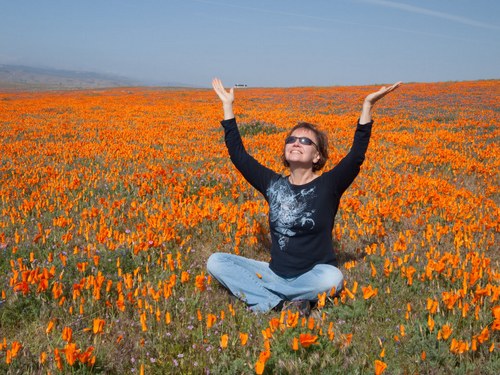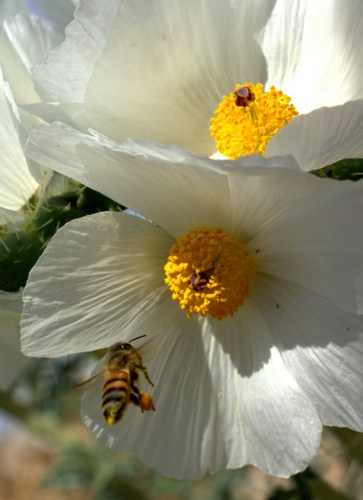Wildflower wonders in Southern California

Every spring of the last five years I’ve felt the rumble, the tingle of curiosity as the question floats into mind: Is it time yet?
Living in the urban areas of Southern California requires survival strategies for sanity. For me, getting out of town regularly is the best medicine. It could be a short day trip or something more exotic but every spring it includes turning the car east and into the desert.
Between March and April of a good year, from the border south and west of Yuma, east to the edge of Death Valley and north into Antelope Valley, lie pockets of startlingly bright desert blooms. One can head out hoping to find them, but it’s best to set a course guided by the latest reports.
There are several great websites to help find the wildflowers:
- Desert USA has detailed area directions to the best blooms and the bonus of a new e-book guiding you to the Desert Sculptures in the Borrego Springs area.
- The Anza Borrego Foundation has a delightfully disguised visitor center and offers activities year round. The grounds are planted with rare specimens of cacti and other desert plants. Their website regularly updates the best wildflower sightings in the area.
- The Bureau of Land Management offers tours of wildflowers and a robust listing of bloom locations. They also have a hotline with visitor updates of the most current conditions.
- When the Antelope Valley Poppy Preserve is in full bloom, it’s better than any CGI special effects. There’s nothing more enchanting than driving a country road, coming over a ridge and encountering a hillside madly washed with dancing, orange blossoms. The phenomenon depends on many of the right conditions all peaking in unison and the last couple of years have been disappointing. The jury’s still out for 2013 as the rains were late in the region and a late frost might kill off the blooms. There are other wonders to enjoy in the region however as tall, purple lupine flowers more consistently. Check out the sites for the latest updates and directions to the peak areas.

A few of the show-off species in the desert regions:
- Ocotillo towers tall and spindly above other desert flora. The bright red flowers shoot out in narrow flutes at the tips of twisting branches. It’s easy to drive by without noticing the blooms that deserve a closer inspection.
- Creosote has a tar-like smell and is one of the most drought resistant plants in the area. In the Mojave Desert, scientists have studied a “king creosote” that’s 11,700 years old. The wiry, flowering shrubs have small, flayed yellow blossoms bursting from white buds.
- The Great Desert Poppy is considered rare and endangered by California Native Plant Society. I’ve been lucky enough to find fields of them south along the southern route to Calexico. The flowers are majestically large above narrow stalks.
- Other desert wildflower rock stars are Wallace’s daisy, whispering bells, desert primrose and common Phacelia. These classic annuals burst out of the arid crust each spring before returning to seed for the long, dry and cold months of the year.
Wildlife: There are other residents in the area that deserve equal attention – if you can find them. Big horn sheep feed on the short-lived desert plants in the shelter of rock lined canyons. There are many lizards, birds and insects wandering the sandy floor. The Anza-Borrego Visitor Center has a pet desert tortoise who hibernates much of the year. When hiking off trail, it’s best to wear closed toe shoes and avoid any snakes, especially coiled rattlers. The youngest have the most lethal bites, so don’t let size encourage risky interference.
A spreading threat: One plant that’s threatening the yearly bloom-fest is the invasion of Sahara Mustard. It’s especially dangerous in the Anza-Borrego Desert State Park but unfortunately, I’ve seen it much further south. The rangy weed crowds out native plants, overshadowing, poisoning and robbing them of precious water. It’s rumored that the plant, a native to North Africa and the Mediterranean, stowed away on a shipment of date palms that were shipped to Palm Springs in 1927. It lingered in patches across the desert for half a century before Hurricane Kathleen doused California in 1976. The plants exploded into early germination soon after and haven’t slowed since.
Researchers are looking for biological agents to keep the Sahara Mustard in check without harming other plants. Tactics include introducing non-native insects which have either helped a bit or disappeared. Whatever the outcome, time is of the essence.
Get out of town: Plan a trip to enjoy the wildflower show soon. You may be looking for an escape from urban sprawl and crowds but be warned, when the blossom parade is spectacular, step carefully through the fields and be prepared to share the wonder with carloads of others, all intent on the same discoveries.
Photos courtesy of Dave Rudie

1 comments